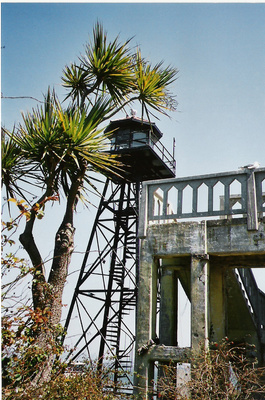New Zealand Cabbage Tree
Did you know that there is a New Zealand Cabbage Tree on the Island of Alcatraz in San Francisco Bay, USA. They even had a little sign saying "New Zealand Cabbage Tree"

All about the Cabbage Tree
The cabbage tree Cordyline australis, known as Tî râkau or Tî kôuka (and, more rarely, whanake) in the Mâori language is a monocotyledon endemic to New Zealand. It grows up to 15 m tall, at first on a single stem, but dividing into a much-branched crown, each branch may fork after producing a flowering stem. The leaves are sword-shaped, 40 to 90 cm long and 3 to 7 cm broad at the base, with numerous parallel veins. The flowers are creamy white, each flower small, about 1 cm diameter with six tepals, and produced in a large, dense cluster 50 to 100 cm long. The fruit is a white berry 5 to 7 mm in diameter.
Because their high carbohydrate content can be made digestible by cooking, they were a valuable food source for at least the first 800 years of Mâori occupation of New Zealand. Radiocarbon dating points to use since about the year 1000. Related trees were probably valuable elsewhere in the South Pacific. Fern root was the only other substantial native carbohydrate source.
The Otago Peninsula is one place where archaeology has shown substantial use of the cabbage tree for food. Huge hollows, up to 7 m across, are the remains of umu-tî (cabbage-tree ovens). After cooking for two days, the bundles of young cabbage tree would be sun-dried, in which state they would keep for years.
Cabbage trees also have value as fibre sources. The trunk and root material can be twisted into ropes, and the leaves can be woven for clothing and footwear fabrics. Juice from the plant has value for fighting infections. Early missionaries "brewed a tolerable beer from it". The commercial value remains to be fully examined. Possibilities are as a low-calorie sweetener (because it is twice as sweet as sugar) and as an ethanol source.
It is also widely planted as an ornamental tree, in New Zealand and also in western Europe (including the British Isles) and the west coast of North America. Because it tolerates cold weather better than many other tree-sized monocots, this plant is often planted by people wishing to give a tropical, exotic look to their yards or gardens. The overall visual effect is said by many to create a view reminiscent of a palm tree (it is occasionally even mis-named "Cornish palm", "Torbay palm" or "Manx palm" in the British Isles due to its extensive use within Torbay and as the official symbol of that area under its alternative identity, the English Riviera). The subspecies (or variety) atropurpurea is especially notable for its reddish foilage, and several cultivars are available.
Since 1987, cabbage trees in New Zealand have been affected by a disease called "Sudden Decline", caused by the pathogen Phytoplasma australiense. The disease usually leads to almost total defoliation of affected trees within 2 to 12 months.
New Zealand Cabbage Tree
Reviews / Comments for New Zealand Cabbage Tree
No reviews have been written write a review now.

